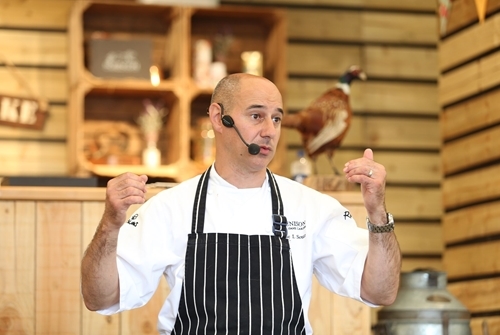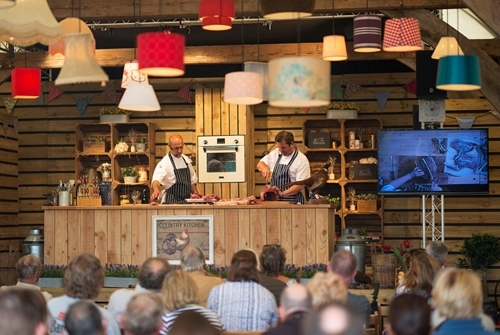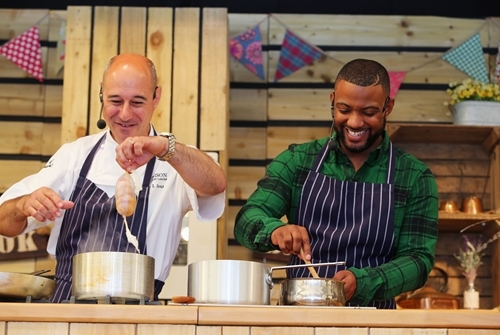
José Souto is one of the leading game chefs in the UK, with an unrivalled knowledge of harvesting, preparing and cooking game. At The Game Fair this year he will be demonstrating his versatility and creativity in The Field Kitchen Theatre by cooking not only with game, but with wild salmon from Alaska too. Here, the senior chef lecturer in culinary arts at Westminster Kingsway College in London explains why he prefers to cook with wild salmon from Alaska.
When it comes sustainable fishing policy, Alaska is a pioneer. I know from personal experience that it is one of the world’s leading authorities on the management of fish stocks and quotas and its programme is something I’m passionate about teaching to my students. I’m always careful about what I promote. When choosing food to cook with, sustainability is always an important factor. That’s why I choose wild Alaska seafood. It also produces superior texture and flavour and is amazing to cook with.
A wild Alaska salmon is born in the rivers and then works its way out to the sea, spends three or four years there and then makes its way back to the river where it was born to spawn. There are millions of fish travelling up these streams and the conservation programme is heavily managed. It controls the number of fish that are caught. The number of fish that go out and down the river is controlled as well.
It’s called ‘escape fishery’. What happens is that fish are allowed to escape upstream. They count the fish by using sonars – and on smaller rivers they actually have people who count them. They work out how many fish have gone upstream and make sure there are enough going to spawn. Then, to ensure that there is enough food for all of the wildlife that is upstream and also to allow man to take a harvest from the fish, they begin that harvest on a day called ‘the opener’. It runs from 7am in the morning until 7pm in the evening.
The following day they put together all the facts and figures, noting how many fish they have caught, how many have gone upstream, how many males and how many females. They look at all that and decide whether to open the fishery again the following day or to close it and allow more fish to escape upstream. So it’s 24-hour fish sustainability. It’s very different to the sustainability programme we have in the UK, where quotas are set much later, a long time after studies have been done. In Alaska it’s all decided upon over 24 or 48 hours.

I know people are going to ask questions about using and promoting salmon all the way from Alaska at The Game Fair, but wild salmon in the UK is not sustainable. As a chef I feel very strongly that I shouldn’t be promoting unsustainable fish.
So I use this phenomenal fish from Alaska as a sustainable substitute. It’s a sockeye salmon, which is very similar to our own wild salmon in the UK. But it’s smaller and has a really rich and deep red colour because of the crustaceans that it eats. The flesh has a muscular texture. Although it contains all the omega 3 oils normally found in any other fish and is very healthy, it doesn’t contain that oiliness that a lot of people don’t like. It’s meaty to taste.
In many ways it is like a piece of tuna, which has a meaty texture. It’s like eating a steak. You have to be very careful that you don’t overcook it and dry it out. With wild Alaska salmon, you have exactly the same problem. You have to be careful not to overcook it.
For taste and texture, sockeye salmon from Alaska is about the only fish I’d use. The only other things I’d use that would come close to that is a farmed sea trout because, again, it has a similar texture and colour to a wild salmon.
I’m looking forward to explaining Alaska’s sustainability programme and sharing my wild salmon recipes at The Game Fair this year. I’ll be demonstrating how to prepare some starter dishes with Alaskan sockeye salmon in The Field Kitchen Theatre.
It will be things like ceviche, which is a raw salmon with a lovely citrus dressing. We’ll be doing some smoking, so we’ll have the Bradley food smoker there and we’ll go through the process of hot smoking salmon and what you can do with it. We’ll also be doing some tartare. Again, it’s a very refreshing dish using salmon and things like capers and gherkins. Please come and join me.
